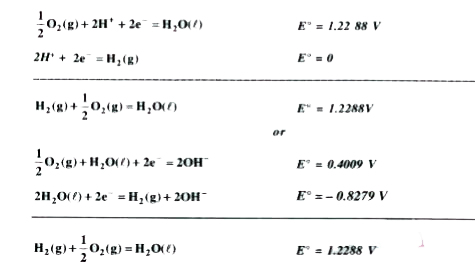Given , Cu2++e−→Cu+E∘=0.15 volt ,Cu++e−→CuE∘=0.5 volt
Calculate potential for Cu2++2e−→CuSolution in Telugu
0.65V
0.325V
0.45V
1.2V
The correct Answer is:B
(3)=(1)+(2),ΔG03=ΔG01+ΔG02,2E03=(1E01+1E02)=0.15+0.52=0.6522,E03=0.325V
Topper's Solved these Questions
- BOOK - AAKASH SERIESCHAPTER - ELECTROCHEMISTRY EXERCISE - PRACTICE SHEET -4 (LINKED COMPREHENSION TYPE QUESTIONS (PASSAGE-I))3videos
ELECTROCHEMISTRY
- BOOK - AAKASH SERIESCHAPTER - ELECTROCHEMISTRY EXERCISE - PRACTICE SHEET -4 (LINKED COMPREHENSION TYPE QUESTIONS (PASSAGE-II))3videos
ELECTROCHEMISTRY
- BOOK - AAKASH SERIESCHAPTER - ELECTROCHEMISTRY EXERCISE - PRACTICE SHEET -3 (INTEGER ANSWER TYPE QUESTIONS )6videos
ELECTROCHEMISTRY
- BOOK - AAKASH SERIESCHAPTER - DILUTE SOLUTIONSEXERCISE - EXERCISE - 1.255videos
DILUTE SOLUTIONS
- BOOK - AAKASH SERIESCHAPTER - ELEMENTS OF D - BLOCKEXERCISE - EXERCISE - 5.233videos
ELEMENTS OF D - BLOCK
Similar Questions
The Edison storage cell is represented as Fe(s)/FeO(s)/KOH(aq)/Ni2O3/Ni(s)
The half - cell reaction are
Ni2O3(s)+H2O(l)+2e−→2NiO+2OH−(aq),E∘=+0.40V
+(s)H2O(l)+2e−→Fe(s)+2OH−(aq),E∘=−0.87V
The cell potential is04:42View Solutionhydrogen-oxygen fuel cell may have an acidic or alkaline electrolyte. The half-cell reactions are

To maximize the power per unit mass of an electrochemical cell, the electronic and electrolytic resistances of the cell must be minimized. Since fused salts have lower electrolytic resistances that aqueous solutions, high-temperature electrochemical cells are of special interest for practical applications.
High temperature also allow the use of liquid metal electrode, which make possible higher current densities than solid electrodes
If 560 mL of H2 gas at STP is fed into and is consumed by the fuel cell in 10 minutes, then what is the current output of the fuel cell?05:27View SolutionThe E∘ at 25∘C for the following reaction is 0.22 V H2(g)+2AgCl(s)→2Ag(s)+2HCl(aq) . If the equilibrium constant at 25∘C is 2.8×10x , x is
03:42View SolutionWhat are the factor on-which solubility depends on ?
02:33View SolutionGive some examples for the ions with pseudo inert gas electronic configuration.
03:42View SolutionCu^(+) + e rarr Cu, E^(@) = X_(1) volt, Cu^(2+) + 2e rarr Cu, E^(@) = X_(2) X_(2) volt For Cu^(2+) + e rarr Cu^(+), E^(@) will be :
View SolutionCiven E^@ for Cu^(2+) rarr Cu^+ is + 0.15 V and Cu^+ rarr Cu is +0.05 V Calculate E^@ for Cu^(2+) rarr Cu .
07:21View SolutionGiven: (i) Cu^(2+)+2e^(-) rarr Cu, E^(@) = 0.337 V (ii) Cu^(2+)+e^(-) rarr Cu^(+), E^(@) = 0.153 V Electrode potential, E^(@) for the reaction, Cu^(+)+e^(-) rarr Cu , will be
04:53View SolutionCu^(+) + e^(-) rightarrow Cu , E^(@) = x1volt , Cu^(2+) + 2e^(-) rightarrow Cu , E^(@) = x_(2) volt, then for Cu^(2+) + e^(-) rightarrow Cu^(+), E^(@) (volt) will be :
02:55View SolutionGiven:
(i) Cu2++2e−→Cu,E∘=0.337V
(ii) Cu2++e−→Cu+,E∘=0.153V
Electrode potential, E∘ for the reaction, Cu++e−→Cu, will be04:42View SolutionGiven :
Cu2++e−→Cu+E∘=0.15 voltCu++e−→CuE∘=0.5 volt
Calculate potential for Cu2++2e−→Cu.View SolutionFor the disproportion of copper: 2 Cu^(+) to Cu^(+2) + Cu E^(0) is :- Given E^(0) for Cu^(+2)//Cu is 0.34 V & E^(0) for Cu^(+2)//Cu^(+) is 0.15 V:
06:29View SolutionE^@ values for the half cell reactions are given below : Cu^(2+) + e^(-) to Cu^(+) , E^@ =0.15 V Cu^(2+) + 2e^(-) to Cu, E^@ =0.34 V What will be the E^@ of the half-cell : Cu^(+) + e^(-) to Cu ?
06:29View SolutionGiven that the standard potentials ((E^(@))) of CU^(2+)//Cu and CU^(+)//Cu are 0.34V and 0.522V respectively , the E^(@) of CU^(2+)//CU^(+) is :
06:29View SolutionCu++e→Cu,E∘=X1 volt,
Cu2++2e→Cu,E∘=X2X_(2) volt
For Cu2++e→Cu+,E∘ will be :04:11View Solution

